Finishing Your Petlyakov Pe-8 Kit? Well....
By E. Pilawskii
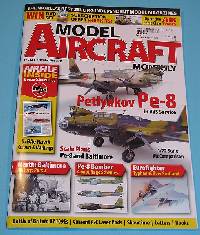
Finishing Your Petlyakov Pe-8 Kit? Well....By E. Pilawskii |
 |
Presumably, it is quite unnecessary to describe the joy of VVS model enthusiasts at the appearance of an injection molded Pe-8 kit. No, wait-- two such kits! Two!? Astounding. And by all accounts, both models are quite buildable, with the Amodel offering representing the M-82 engined version, and the Zvezda kit with AM-35 engines. Detailed reviews of each kit will, no doubt, appear elsewhere.
Our purpose in this article, however, is not to moot the finer technical details of each kit, but rather to entertain the idea of how one should finish them. Indeed, having spent what would surely be considerable effort on the build, itself, the project would certainly require some splendid, authentic and accurate painting, no? But, of course. So, let us look at the various painting guides available and see what, if anything, may be useful in them.
It is important to review, firstly, what we know about Pe-8 camouflage and finish prior to an examination of these options. There is currently no evidence known to myself-- either documentary nor photographic-- of a Pe-8 finished in any aviation lacquer besides the older AII (or, 'A2' if one prefers) types, save of course for the use of MK-6 noch' undersurfaces and MK-7 White winter finish. The preference for the use of these older finishes, even after the introduction of AMT lacquer, at factories building larger (bombers, etc) aircraft is strongly documented. It should be borne in mind that Factory 124 (the original TB-7 plant) was absorbed into the operation of Factory 22 [this is a rather involved story, actually, not suitable for examination here] during 1942. The painting behaviour of Factory 22 -- manufacturers of the Pe-2 -- is well understood and represented competently by considerable remaining physical evidence. This evidence shows a marked preference for AII lacquer, which was employed until well after the GPW (for example, six of the seven remaining unmodified Pe-2/-3 structures exhibit AII paint), although some AMT finished examples also were completed from later 1943 onwards. At the same time, these remaining structures also show a marked preference for the use of AMT finishes in field situations-- all of the repaired areas known on these examples were re-painted with AMT colours. It is therefore interesting to wonder what might happen in cases of considerable ex-factory work on Pe-8s.
Four distinct pattern applications have been identified on the Pe-8 so far, in addition to the pre-War 'non-camouflage' single-colour upper surface livery. No examples of three-colour camouflage are known to me. Furthermore, it is useful to bear in mind that the Pe-8 was never really the subject of mass production, at least in the usual employment of that phrase. The various aircraft were highly individualistic, and indeed this is so in terms of painting at the factory. No two Pe-8 examples have been seen yet which were identical in finish. Ergo, it is very difficult to postulate a generic scheme nor pattern for these aircraft, something which leads to great uncertainty about their respective appearance.
However, researcher M. Maslov does not faff about. If examples of colour profiles have appeared in his typically superb work, "Heavy Bomber Pe-8" [Tseykhgauz, 2006], it is certainly possible that either he has photographs showing three-colour schemes on Pe-8s in his collection, or has seen such. On the other hand, Maslov does not hold himself as an expert on such detail colouration matters (rightly, as that would be unprofessional), and the book artist might simply have finished the profiles this way as a matter of informed speculation. Only Mr. Maslov, himself, can clarify this matter.
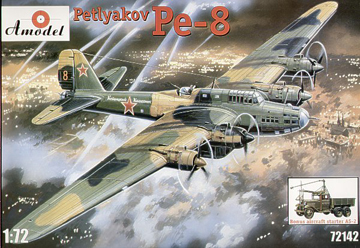 It would
appear that in both cases the Amodel and Zvezda kits, respectively, feature
only one camouflage/markings option-- that being the same as shown on the box
artwork. Both schemes look surely to be based on the colour profiles presented
in Mikhail Maslov's book [see above].
It would
appear that in both cases the Amodel and Zvezda kits, respectively, feature
only one camouflage/markings option-- that being the same as shown on the box
artwork. Both schemes look surely to be based on the colour profiles presented
in Mikhail Maslov's book [see above].
The Amodel box shows a colouration which is somewhat difficult to identify. The pattern in view is roughly in agreement with the 1943 NKAP recommendations for such aircraft, but the colours appear to be older-- AII Light Brown and Black over some kind of "dull green", and MK-6 undersurfaces. The markings are those for Production Number 42210 of the 25 GvAP of the ADD. The origin of the "Red 8" tactical marking is unknown, as this does not appear on the profile in Maslov's book, but the inscription "Kaybitskiy Kolkhoznik" is present.
The Maslov book profile shows what I believe was intended as an NKAP template scheme in AMT-4/-12/-1 and MK-6 unders (with the brown colour looking decidedly like AII Light Brown; but perhaps this is a print or replication difficulty?). It shows signs of considerable re-finish, deviating from the template in a manner suggesting repair or repainting work. Pe-8 p/n 42210 was built during the summer of 1943, and so it is at least possible that it might have been completed in such a scheme. Without access to the photograph of this aircraft, it is simply impossible to say what might be in view.
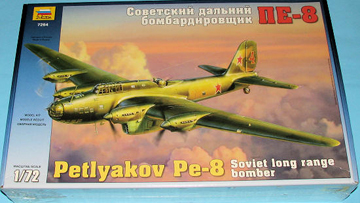 The
intended colouration of the Pe-8 example for the Zvezda kit is not overly apparent
from the box-top artwork (demonstrating, as it does, highly attractive artistic
lighting). Certainly it looks to be a three-colour scheme, with blue undersurfaces.
The markings are those from another Maslov book profile, this depicting "Red
4" (p/n 42107) of the 746 AP of the ADD.
The
intended colouration of the Pe-8 example for the Zvezda kit is not overly apparent
from the box-top artwork (demonstrating, as it does, highly attractive artistic
lighting). Certainly it looks to be a three-colour scheme, with blue undersurfaces.
The markings are those from another Maslov book profile, this depicting "Red
4" (p/n 42107) of the 746 AP of the ADD.
The over-all impression of this scheme, to my eye, is one of AII colouration-- Green/Brown/Light Brown. This idea is bolstered somewhat by the description given in the Scale Aviation Modeller International review of the Pe-8 (Aug/08 issue). In this, the author appears to complain that Zvezda's colour suggestion was a "very reddish shade"; that sounds a bit like AII Brown, perhaps. However, the remaining colour was said to be black, so perhaps the instructions sheet had thought to suggest AII Green/Brown/Black?
The book profile is neither here nor there. It has the appearance (of course, subject to the results of the printing method, so be warned) of AMT-1 and AMT-6 over AMT-4. In other words, not an NKAP scheme, neither in a pattern resembling that template. However, p/n 42107 was completed in 1941-- that is to say, two years before the issue of the NKAP recommendations, and well before AMT lacquers even came into existance. All of the known camouflage applications from 1941 are AII Green/Black, which weighs rather heavily against any three-colour interpretation.
With all these things in mind, it must therefore be suggested that the appearance is incorrect. While a three-colour scheme using lacquers AII Green/Black/Brown is possible (according to the application and practice of camouflage in 1941), it is not likely. The most likely answer is that p/n 42107 was finished in one of the early pattern AII Green/Black applications.
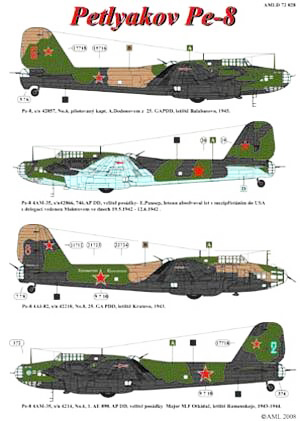 AML has released, virtually simultaneously, a set of decals for the Pe-8 (sheet
#72028). Four schemes are provided on the sheet, of which three appear to be
intended for the Zvezda kit (with its AM-35 engines). Curiously, the M-82 engine
scheme provided is the same as that provided in the Amodel kit; does this suggest
any type of co-operation between the two companies on this matter?
AML has released, virtually simultaneously, a set of decals for the Pe-8 (sheet
#72028). Four schemes are provided on the sheet, of which three appear to be
intended for the Zvezda kit (with its AM-35 engines). Curiously, the M-82 engine
scheme provided is the same as that provided in the Amodel kit; does this suggest
any type of co-operation between the two companies on this matter?
The first decal option depicts Pe-8 "Red 6" (p/n 42057), said to be of the 25 GvAP of the ADD. We know that this machine had a red tactical numeral "6" applied to it at the factory, but the appearance of the aircraft cannot be known minus its corresponding photograph. 42057 was completed at the beginning of 1942, and therefore very likely was finished in AII Green and Black with AII Blue unders at that time. The decal sheet scheme shows "Red 6" with MK-6 undersurfaces, which if correct must have been applied subsequently in service. The scheme is captioned to have dated from 1945, and if true the finish would been been quite worn, except in the case of field refinishing.
Option number two on the sheet is intended for the most famous and well-documented of all Pe-8s, p/n 42066. This aircraft famously transported Vyacheslav Molotov to the USA and Scotland during 1942 for various talks, and was extensively photographed by the receiving parties. The instructions appear to suggest the correct colouration for this aircraft-- AII Green/Black/Blue-- but the pattern in view could use some correction. As well, the decal sheet is lacking the tactical number "Red 1", albeit happily this item will not be hard to replicate.
As with all Pe-8 examples, great care must be taken with the individual details of each machine. In this case, sufficient photographic evidence exists to describe many of these items. For example, 42066 was built at the factory with M-30 diesels, only to be re-fitted with AM-35As prior to acceptance by the VVS. These engines sport the earlier six exhaust stack arrangement, and so must be compared to the kit parts. The aft turret mounted a 20 mm ShVAK when it was photographed-- despite having been documented earlier in the records of the 412 AP with a ShKAS here-- and carried 12.7 mm UBT weapons in the under-wing turrets. And so on... as mentioned, each Pe-8 was virtually hand-built, and they tended to be highly individual. The camouflage and finish of 42066 will be discussed below.
The third sheet option is that for M-82 engined Pe-8 p/n 42210. The details are identical to those of the Amodel kit's decals.
The final option provided is for Pe-8 "Blue 2" of the 890 AP, ADD (p/n 4214). There is a known aerial shot of an early Pe-8 with a numeral "2" on the fin (of this appearance) which one presumes has been either identified as 4214, or simply has been copied as the prototype for its appearance [see V Rigmant's TB-7/Pe-8 book, p.41, for example]. The quality of this image is strictly limited, showing only an AII Green/Black camouflage with indeterminate undersurfaces (so stark is the shading in the picture).
A profile of this aircraft is presented in the Maslov book along with an upper surface view. The profile depicts the coluration as, essentially, that of AII Green/Black, and with MK-6 unders. The upper view demonstrates a pattern with distinctly "VVS-looking" shapes to the application, which adds an air of plausibility about the appearance. However, it is not a pattern which I recognise, nor is it seen on any other known Pe-8; it would be interesting to learn if there exist additional photographs of this example. The profile's use of Victory type national markings in the 1943 time-frame is hugely improbable; plain or white bordered stars would be recommended.
4214 was an early machine, the fourth production example, built in the autumn of 1940. It was too early for MK-6 finish, and at the time of manufacture would surely have worn an AII Green/Black/Blue livery, with the black unders applied later in service. When built, the aircraft was powered by AM-34FNV motors with the ATsN-2 supercharger, but was later re-engined with AM-34As. This fact will require some surgical work on the kit's engine nacelles for those wishing to pursue this machine. The 412 AP's armament schedule for 4214 lists ShKAS guns fore and aft, with UBT guns in the under-wing turrets (mind, we have seen in other cases that the armament was understandably changeable).
One of the schemes most likely to be completed with the Zvezda kit is that for our famous machine, 42066. This aircraft, the 28th production example, was relatively new when it transported Molotov around for his various diplomatic undertakings. The available photographs of this aircraft in Scotland reveal a relatively fresh appearance.
The mechanical outfit of 42066 is described above. In terms of finish and colouration, a great deal is known about this machine by way of the extensive "clandestine" spying which was attempted by its Allied hosts**. Many photographs were taken in this effort, including a fine shot from above which reveals the camouflage pattern well. Based upon this extensive evidence, we can summarise the appearance of this aircraft:


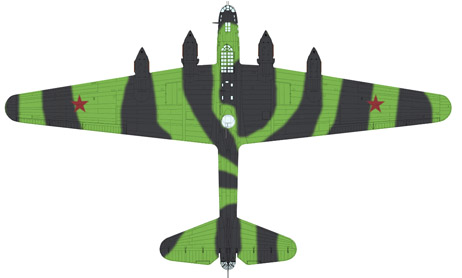
| ** These various attempts to surreptitiously photograph the aircraft were a matter of enormous amusement to the VVS crew. After informing the assembled spies that photography from under the coat jacket lead to poor results, Maj. Pusep (the aircraft commander) invited the assembled RAF personnel for an extensive and completely open tour of the Pe-8, freely answering any and all questions regarding the technical details of the machine. It is from these tours and discussions that Western knowledge of 42066's details (for example, even such minutea as the production number) were gleaned. |